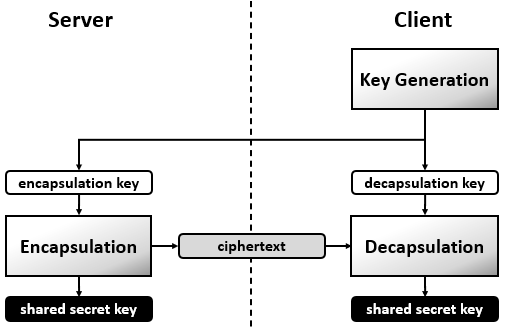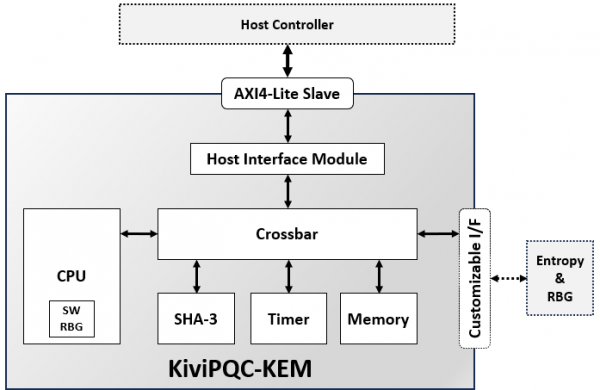Silicon IP Cores
KiviPQC-KEM
ML-KEM Key Encapsulation IP Core
The KiviPQC™-KEM IP core is a hardware accelerator for post-quantum cryptographic operations. It implements the Module Lattice-based Key Encapsulation Mechanism (ML-KEM), standardized by NIST in FIPS 203. This mechanism realizes the appropriate procedures for securely exchanging a shared secret key between two parties that communicate over a public channel using a defined set of rules and parameters. The KiviPQC-KEM IP core supports key generation, encapsulation, and decapsulation procedures, making it suitable for both (client/server) sides of key exchange.
The solution supports all three parameter sets for ML-KEM, i.e. ML-KEM-512, ML-KEM-768, and ML-KEM-1024. It is based on a RISC-V-like SoC topology and includes a 32-bit RISC-V based processor. The resulting shared key is of 32 bytes. Beyond that, the main components of the core are a SHA-3 cryptographic hash accelerator, a hardware timer module, and a crossbar interconnect module for internal data routing. The communication with the host is accomplished by a Host Interface Module handling specific control and data flow, connected with an AMBA® AXI4-Lite slave port. Finally, the core is currently offered with a software implementation of a Random Byte Generator (RBG). Beyond that, it is able to be integrated with an external (third-party) entropy source and RBG via a fully customized interface, depending on the entropy/RBG selection.
The KiviPQC-KEM IP core provides hardware acceleration for computationally intensive operations while maintaining a small footprint and can be integrated into any system-on-chip (SoC) for ASIC or FPGA implementation. Beyond that, it combines a minimal attack surface with modest resource requirements for future-proof and quantum-safe systems.
The core realizes a quantum-safe exchange of a shared secret key between two parties (client and server) communicating over a public channel. During the key sharing, the client generates a decapsulation key and an encapsulation key, keeps the first as private and sends the second as public to the server. The server generates a copy of the shared key and an associated ciphertext using the client’s encapsulation key and sends it to the client. Finally, the client generates a copy of the same shared key using the ciphertext received from the server and the kept private decapsulation key.

The KiviPQC-KEM IP core offers quantum-resistant security for a wide range of applications. In public-key infrastructure and cloud security, it ensures long-term confidentiality and integrity for sensitive information. It can play a vital role in safety-critical infrastructure and networks, safeguarding communication and exchange channels from potential threats. In the realm of secure IoT device communication, the core provides strong cryptographic support to protect shared secret keys. Additionally, it is well-suited for hardware security modules (HSMs) and Trusted Platform Modules (TPMs), enhancing secure key management and cryptographic processing. Its capabilities extend to supporting MACsec key agreement (MKA) protocols for secure Ethernet communications, Internet Key Exchange (IKEv2) protocols, strengthening VPN and secure network authentication mechanisms, and edge computing.
The KiviPQC-KEM core can be mapped to any ASIC technology. The following are sample ASIC pre-layout results, reported from synthesis with a silicon vendor design kit under typical conditions, with all core I/Os assumed to be routed on-chip. Indicative synthesis results are shown for all three ML-KEM parameter sets (ML-KEM-512, ML-KEM-768, and ML-KEM-1024) as defined in FIPS-203.
|
ML-KEM Parameter |
Technology |
Logic Resources |
Memory Resources |
Frequency |
|---|---|---|---|---|
|
512
|
TSMC 7nm
|
123k eq. gates
|
104 KiB
|
700 MHz |
|
512
|
TSMC 16nm
|
114k eq. gates
|
104 KiB
|
600 MHz |
| 512 | TSMC 16nm | 101k eq. gates | 104 KiB | 100 MHz |
| 512 | TSMC 28nm HPC | 111k eq. gates | 104 KiB | 500 MHz |
| 512 | TSMC 40nm | 149k eq. gates | 104 KiB | 500 MHz |
| 768 | TSMC 7nm | 132k eq. gates | 104 KiB | 100 MHz |
| 768 | TSMC 16nm | 146k eq. gates | 104 KiB | 600 MHz |
| 768 | TSMC 16nm | 133k eq. gates | 104 KiB | 100 MHz |
| 768 | TSMC 40nm | 156k eq. gates | 104 KiB | 100 MHz |
| 1024 | TSMC 7nm | 165k eq. gates | 104 KiB | 100 MHz |
| 1024 | TSMC 16nm | 181k eq. gates | 104 KiB | 600 MHz |
| 1024 | TSMC 16nm | 166k eq. gates | 104 KiB | 100 MHz |
| 1024 | TSMC 40nm | 194k eq. gates | 104 KiB | 100 MHz |
The reported memory resources concern three single-port memories, i.e. two ROMs of 8 KiB and 64 KiB and one RAM of 32 KiB. The provided figures do not represent the highest speed or smallest area possible for the core. Please contact CAST to get characterization data for your target configuration and technology.
The KiviPQC-KEM core can be mapped to any Altera® FPGA device (provided sufficient silicon resources are available). The following are sample results, for ML-KEM-512 FIPS-203 parameter, with all core I/Os assumed to be routed on-chip.
|
Family (Speed Grade) |
Logic Resources |
Memory Resources |
Frequency |
|---|---|---|---|
|
Agilex 7 (-2)
|
14,796 ALMs
|
72 RAMB18
|
230 MHz
|
|
Arria 10 (-2)
|
7,839 ALMs
|
72 RAMB18
|
115 MHz
|
| Cyclone 10 GX+ (-5) | 7,977 ALMs | 72 RAMB18 | 154 MHz |
| Stratix 10 (-3) | 14,065 ALMs | 72 RAMB18 | 143 MHz |
The provided figures do not represent the highest speed or smallest area possible for the core. Please contact CAST to get characterization data for your target configuration and technology.
The KiviPQC-KEM core can be mapped to any AMD® FPGA device (provided sufficient silicon resources are available). The following are sample results, for ML-KEM-512 FIPS-203 parameter, with all core I/Os assumed to be routed on-chip.
|
Family (Speed Grade) |
Logic Resources |
Memory Resources |
Frequency |
|---|---|---|---|
|
Kintex 7 (-3)
|
8,158 LUTs
|
72 RAMB18
|
119 MHz
|
|
Spartan 7 (-2)
|
8,158 LUTs
|
72 RAMB18
|
75 MHz
|
| Zynq US+ (-3) | 8,158 LUTs | 72 RAMB18 | 175 MHz |
The provided figures do not represent the highest speed or smallest area possible for the core. Please contact CAST to get characterization data for your target configuration and technology.
The core as delivered is warranted against defects for ninety days from purchase. Thirty days of phone and email technical support are included, starting with the first interaction. Addi-tional maintenance and support options are available.
This core implements encryption functions and as such it is subject to export control regulations. Export to your country may or may not require a special export license. Please contact CAST to determine what applies to your specific case.
Features List
NIST FIPS Compliant
- Module Lattice-based Key Encapsulation Mechanism (ML-KEM)
- NIST FIPS 203
- All three ML-KEM parameter sets
- 512 / 768 / 1024
Enhanced Security
- Self-contained engine with a minimal attack surface
- Protection against timing-based side channel attacks
Resource-Efficient Acceleration
- Hardware offloading and acceleration of time-consuming PQC operations
- Minimal logic utilization
Straightforward SoC Integration
- Lightweight, simple-control AMBA® AXI4 Interface
- Re-usable design, LINT-clean
Deliverables
- RTL source code (System Verilog)
- HAL and drivers for integration
- Complete testbenches
- Simulation and synthesis scripts
- Documentation

